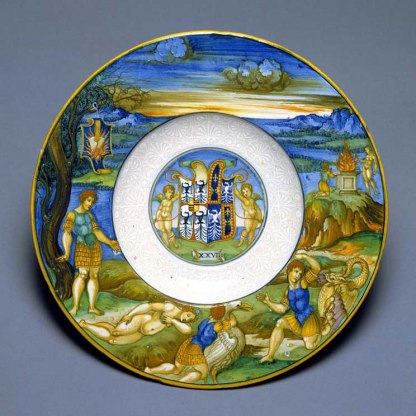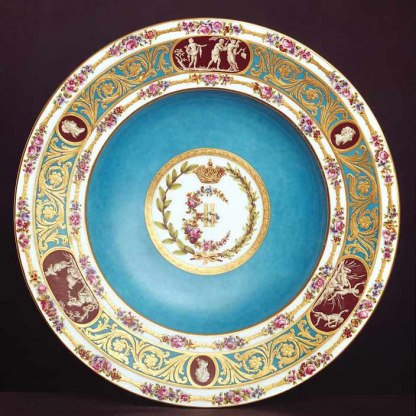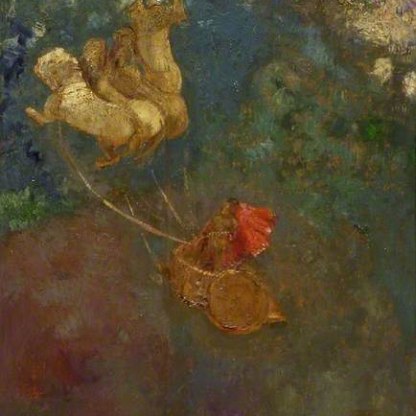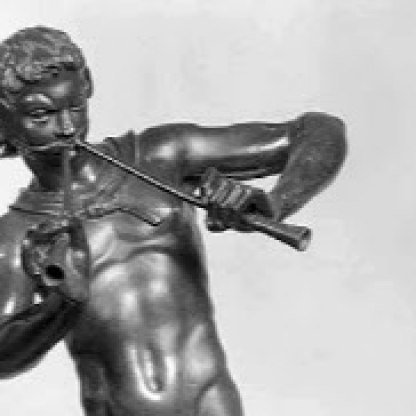Peleus and Thetis
Proteus, a sea god, has prophesied that Thetis, a nymph, will bear a son greater than his father. Zeus had intended to seduce Thetis himself, but fearing Proteus' prediction, he sends instead his grandson Peleus to ravish her.
The episode found on Nicola da Urbino's dish occurs at Ovid's Metamorphoses, 11, 217–65:
There is a bay in Haemonia, curved round in an arc like a sickle, with arms that run out in to the sea. If the water there were deeper it would be a harbour, but the sea spreads out level over the sandy floor. It has a firm shore that holds no footprints and hinders no travellers. It is not smothered in seaweed. Near it is a myrtle grove where variously coloured berries grow. In the middle a cavern...[where] Thetis often used to go, riding naked on her bridled dolphin. And it was there that Peleus seized her, as she lay bound in sleep.
The nymph resisted when he tried to plead with her; so, having wound both arms around her neck, he prepared to use force. If she had not frequently changed her shape – a familiar trick – he would have overcome her with his bold attack.
But now she was a bird, and he continued holding onto her as a bird.Now she was a heavy tree, and Peleus clung to it. The third shape she took on was a striped tiger, and Peleus was terrified and loosened his arms from its body.
Then he prayed to the gods, pouring wine on the sea-water and honouring them with cattle's entrails and incense smoke, until the Carpathian prophet Proteus appeared from the middle of the sea's swirl and spoke.
'Son of Aeacus, you can have the lovemaking you're after. All you have to do is wait until Thetis is relaxed, asleep in her stony cave. Then tie her up, unawares, with cords and tight bindings. Don't be fooled by the hundred false shapes she makes, but hold her close whatever she is, until she resumes her original shape.' When Proteus had said this, he hid his face in the sea and cast waves over his final words.
The sun was lying low and holding to the western waters with his chariot bearing down, when the beautiful Nereid, Thetis, left the sea and walked into her bedchamber. Peleus had scarcely moved onto her virgin limbs before she changed her shape. But eventually she could feel that her limbs were held and her arms were spread wide apart.
At last she groaned. 'You've won,' she said, 'and not without some god's help.' And she revealed herself as Thetis. The hero had prevailed by his prayers. He embraced her as she admitted defeat, and filled her with the mighty Achilles.
Nicola and the artist of the woodcut from which he derived his design have departed in some ways from Ovid's narrative. Here after becoming a bird, Thetis becomes a dragon to force Peleus' retreat. And rather than the old man Proteus answering the hero's prayer at the burning altar, a young, naked goddess has emerged from the sea, perhaps Venus, the goddess of love.
Other highlight objects you might like
Other pathways and stories you might like
Sign up to our emails
Be the first to hear about our news, exhibitions, events and more…






